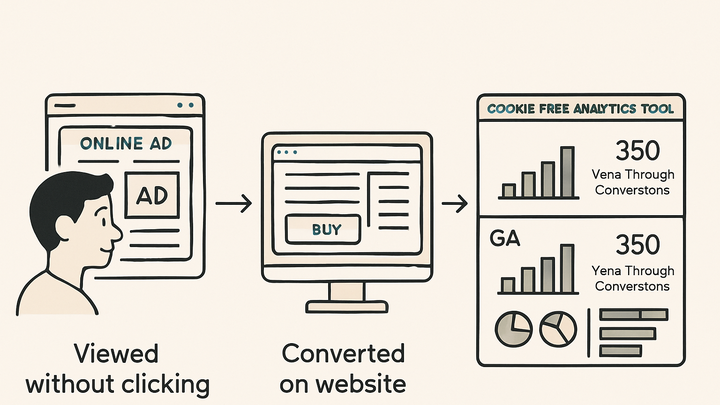Published on 2025-06-22T10:16:17Z
What is a View-Through Conversion? Definition and Examples
View-Through Conversion (VTC) is a metric in digital analytics that attributes a conversion to a user who saw an advertisement but did not click it, then converted later. It captures the impact of ad impressions that drive awareness and influence user behavior indirectly. Unlike click-through conversions, which require a direct click, view-through conversions track impression events and subsequent conversion actions within a defined attribution window. This metric fills gaps in traditional click-based attribution models by recognizing the value of passive ad exposure. VTCs are essential for comprehensive ROI measurement and media mix optimization, particularly in display and video advertising. However, they require careful configuration and interpretation to account for viewability standards, privacy regulations, and potential over-attribution of conversions.
View-through conversion
A metric that credits conversions to ad impressions without clicks, capturing passive exposure and boosting multi-touch attribution accuracy.
Understanding View-Through Conversions
This section explains what a view-through conversion is and how it functions within digital analytics and attribution models.
-
Definition
View-through conversion credits a conversion to a user who saw an ad impression but did not click it. It tracks impression events and subsequent conversions within a set attribution window.
-
How it works
When a user is served an ad, an impression is recorded. If the user later visits the site and completes a defined conversion action within the attribution window (e.g., 7 or 30 days), the platform attributes that conversion to the earlier impression.
Importance in Analytics & Marketing
Learn why view-through conversions are critical for measuring the full impact of advertising campaigns beyond just clicks.
-
Holistic attribution modeling
View-through conversions ensure that passive ad exposures are counted when measuring campaign performance, leading to more comprehensive ROI analysis and balanced attribution across channels.
-
Improving media mix decisions
By accounting for view-through conversions, marketers can optimize budgets across display, video, and other non-click channels that drive awareness but might not get direct clicks.
Implementing View-Through Tracking
Guidance on setting up view-through conversion tracking in popular analytics platforms, with code examples and privacy considerations.
-
Google analytics 4 (GA4)
GA4 automatically tracks view-through conversions for eligible Google Ads campaigns when linked and configured. Ensure you have linked your Google Ads account, enabled auto-tagging, and defined the appropriate conversion events under “Conversions”. Adjust the view-through lookback window in Google Ads settings to match campaign goals.
-
PlainSignal (cookie-free analytics)
PlainSignal offers simple, privacy-focused analytics that can track view-through conversions without cookies. To implement, add the PlainSignal script to your site and define conversion events via the tracking code. Below is an example setup:
-
Tracking code example
<link rel="preconnect" href="//eu.plainsignal.com/" crossorigin /> <script defer data-do="yourwebsitedomain.com" data-id="0GQV1xmtzQQ" data-api="//eu.plainsignal.com" src="//cdn.plainsignal.com/plainsignal-min.js"></script>
-
Best Practices & Limitations
Explore guidelines for accurate view-through conversion setup and understand the limitations to ensure reliable data interpretation.
-
Setting appropriate attribution windows
Choose a view-through lookback window that aligns with the typical conversion cycle for your business (e.g., 7, 30, or 90 days). Longer windows may attribute unrelated conversions, while shorter windows might miss genuine delayed conversions.
-
Addressing privacy and viewability
Since view-through tracking relies on impression data, ensure compliance with privacy regulations like GDPR by avoiding third-party cookies and focusing on viewability metrics (e.g., audibility, viewable duration) to improve accuracy and reduce fraud.
-
Interpreting data with caution
View-through conversions can overstate ad impact if users convert through other channels. Use them alongside click-through data and multi-touch attribution models to get a balanced view of performance.
